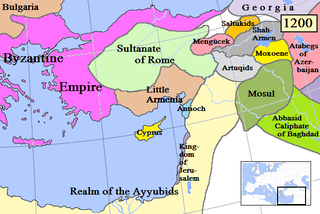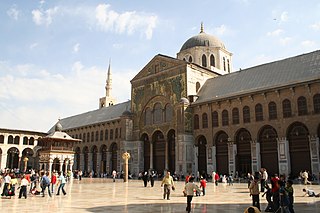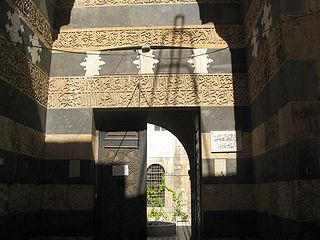
The Jayrun Water Clock, a water clock built by the Muslim engineer Muhammad al-Sa'ati, was positioned at the gate of Damascus, Syria, at the exit of the Umayyad Mosque in the 12th century during the reign of Nur ad-Din Zangi. [1]

The Jayrun Water Clock, a water clock built by the Muslim engineer Muhammad al-Sa'ati, was positioned at the gate of Damascus, Syria, at the exit of the Umayyad Mosque in the 12th century during the reign of Nur ad-Din Zangi. [1]
There is a full description of the clock in the treatise Ktab 'Amal al-sa'at wa-l-amal biha (On the Construction of Clocks and their Use) written by Ridwan b. al Saati in 1203. This treatise describes the reconstruction by Ridwan of the water clock which was built by his father, Muhammad al-Saati, in the reign of Nur al-Din Mahmud b. Zanki in Damascus (reigned 1154–74). "The clock-face consisted of wall of timber about 4.23 metres wide and 2.78 metres high. In this screen was a row of doors, at either end of which was the figure of a falcon. During the day a small crescent moved at constant speed in front of the doors and at every hour a door rotated to reveal a different colour, the falcons leant forward, discharged pellets on to cymbals and resumed their upright positions. Above the doors a zodiac circle rotated at constant speed. Above this was a semicircle of twelve circular holes. During the night one of these holes became fully illuminated every hour. The clock was operated by the "Archimedes" water machinery and the motion transmitted to the activating mechanisms by pulley and rope systems." [2] [3]
In 1203, al-Sa'ati's son Ridwan wrote a treatise on how he had been tasked to repair the clock his father had built, after others had failed.
A full-size reconstruction of the clock can be seen in the Nationaal Beiaard- en Natuurmuseum Asten in the Netherlands.

Nūr ad-Dīn Abū al-Qāsim Maḥmūd ibn ʿImād ad-Dīn Zengī, often shortened to his laqabNur ad-Din, was a member of the Oghuz Turkish Zengid dynasty which ruled the Syrian province of the Seljuk Empire. He reigned from 1146 to 1174.
Nuruddin is a male Arabic given name, translating to "light of the religion", nūr meaning "light" and dīn meaning "religion". More recently, the name has also been used as a surname.

Ahmed Kuftaro or Ahmad Kaftaru was the Grand Mufti of Syria, the highest officially appointed Sunni Muslim representative of the Fatwa-Administration in the Syrian Ministry of Auqaf in Syria. Kaftaru was a Sunni Muslim of the Naqshbandi Sufi Tariqa.

Taqi al-Din Muhammad ibn Ma'ruf ash-Shami al-Asadi was an Ottoman polymath active in Cairo and Istanbul. He was the author of more than ninety books on a wide variety of subjects, including astronomy, clocks, engineering, mathematics, mechanics, optics and natural philosophy. In 1574 the Ottoman Sultan Murad III invited Taqī ad-Dīn to build the Constantinople observatory. Using his exceptional knowledge in the mechanical arts, Taqī ad-Dīn constructed instruments like huge armillary and mechanical clocks that he used in his observations of the Great Comet of 1577. He also used European celestial and terrestrial globes that were delivered to Istanbul in gift-exchange. The major work that resulted from his work in the observatory is titled "The tree of ultimate knowledge [in the end of time or the world] in the Kingdom of the Revolving Spheres: The astronomical tables of the King of Kings [Murād III]". The work was prepared according to the results of the observations carried out in Egypt and Istanbul in order to correct and complete Ulugh Beg’s Zij as-Sultani. The first 40 pages of the work deal with calculations, followed by discussions of astronomical clocks, heavenly circles, and information about three eclipses which he observed at Cairo and Istanbul. For corroborating data of other observations of eclipses in other locales like Daud ar-Riyyadi, David Ben-Shushan of Salonika.

The Artuqids or Artuqid dynasty was a Turkmen dynasty originated from Döğer tribe that ruled in Eastern Anatolia, Northern Syria and Northern Iraq in the eleventh and twelfth centuries. The Artuqid dynasty took its name from its founder, Zaheer-ul-Daulah Artuk Bey, who was of the Döger branch of the Oghuz and ruled one of the Turkmen atabeyliks of the Seljuk Empire. The Artuqid rulers viewed the state as the common property of the dynasty members. Three branches of the family ruled in the region: Sokmen Bey's descendants ruled the region around Hasankeyf between 1102 and 1231; Necmeddin Ilgazi's branch ruled from Mardin between 1106 and 1186 ; and the Mayyafariqin Artuqid line ruled in Harput starting in 1112, and was independent between 1185 and 1233.

The Umayyad Mosque, also known as the Great Mosque of Damascus, located in the old city of Damascus, is one of the largest and oldest mosques in the world.

Rukneddine or Rukn al-Din is a district of Damascus, Syria. In the 2004 census, it had a population of 92,646. It is the historic Kurdish quarter of the city.

The Az-Zahiriyah library or Madrasa al-Zahiriyya is a historic library, madrasa, and mausoleum in Damascus, Syria. It dates back to 1277, taking its name from Sultan al-Zahir Baybars (1223–1277) who is buried here.
Ibn Asakir was a Sunni Islamic scholar, a historian and a disciple of the Sufi mystic Abu al-Najib Suhrawardi.

The Citadel of Damascus is a large medieval fortified palace and citadel in Damascus, Syria. It is part of the Ancient City of Damascus, which was listed as a UNESCO World Heritage Site in 1979.
Pseudo-Archimedes is a name given to pseudo-anonymous authors writing under the name of 'Archimedes' as quoted by various sources of the Islamic Golden Age such as Al-Jazari for the construction of water clocks. Archimedes himself is not known to have written any such manuscript.

Dar al-Magana is a house in Fes, Morocco, built by the Marinid Sultan Abu Inan Faris which holds a weight-powered water clock. The muwaqqit Abou al-Hassan Ibn Ali Ahmed Tlemsani was responsible for building the clock, which was finished on 6 May 1357. The Dar al-Magana is opposite the Bou Inania Madrasa and connected to this school.
Khayr al-Din ibn Ahmad ibn Nur al-Din Ali ibn Zayn al-Din ibn Abd al-Wahab al-Ayubi al-Farooqui (1585–1671), better known as Khayr al-Din al-Ramli, was a 17th-century Islamic jurist, teacher and writer in then Ottoman-ruled Palestine. He is well known for issuing a collection of fatwas that became highly influential in Hanafi jurisprudence in the 18th and 19th centuries.
The Ridwan dynasty was the most prominent pasha family in Palestine, ruling the southwestern districts of the Damascus Eyalet in the 16th and 17th centuries under Ottoman rule. The dynasty was based in Gaza, where its members continuously served as the hereditary sanjak-beys of the sanjak for over a century. Members also ruled different provinces and districts throughout the Ottoman Empire and held additional titles at different times. The Ridwan period in Gaza was considered the city's last golden age.

Salah El Din Ibn Mahmud Al Hasani Al Tijany Al Masri is an Egyptian Imam, Mujtahid and a specialist of Hadith affiliated to the Sunni Ash'ari theological school, the Maliki school of jurisprudence, and the Tijani tariqa. He is also an orthopedic surgeon and Professor of Medicine at the Faculty Of Medicine Kasr Al Ainy of Cairo.
Burhān al-Dīn Ibrāhīm ibn Muḥammad ibn Ibrāhīm al-Ḥalabī was an Islamic jurist (faqīh) who was born around 1460 in Aleppo, and who died in 1549 in Istanbul. His reputation as one of the most brilliant legists of his time chiefly rests on his work entitled Multaqā al-Abḥur, which became the standard handbook of the Ḥanafī school of Islamic law in the Ottoman Empire.
Alam al-Din Ibn-Abidin al-Hanafi was an Egyptian mathematician, astronomer and engineer during the Ayyubid period.
Fakhr al-Din Ridwan ibn Muhammad ibn Ali ibn Rustam al-Khurasani al-Sa'ati, better known as Fakhr al-Din ibn al-Sa'ati, was an Arab physician and writer known for his knowledge of "philosophical disciplines" and clockmaking. Born and raised in Damascus, Fakhr al-Din ibn al-Sa'ati was a son of Muhammad ibn Ali ibn Rustam al-Khurasani al-Sa'ati, a prominent clockmaker and astronomer who hailed from "Khurāsān in eastern Iran" but had moved to Damascus in Syria. Fakhr al-Din's brother, Bahāʾ al-Din ibn al-Sa'ati, a poet, achieved prominence under the Ayyubids.
'Ala' al-Din al-Bukhari, was a Hanafi jurist (faqih), Maturidi theologian, commentator of the Qur'an (mufassir), and a mystic (Sufi). Sa'id Foudah suggest that he followed the Naqshbandi path.